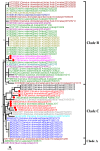Middle East Respiratory Syndrome Coronavirus (MERS-CoV) in Dromedary Camels in Africa and Middle East
- PMID: 31387326
- PMCID: PMC6723520
- DOI: 10.3390/v11080717
Middle East Respiratory Syndrome Coronavirus (MERS-CoV) in Dromedary Camels in Africa and Middle East
Abstract
: Dromedary camels are the natural reservoirs of the Middle East respiratory syndrome coronavirus (MERS-CoV). Camels are mostly bred in East African countries then exported into Africa and Middle East for consumption. To understand the distribution of MERS-CoV among camels in North Africa and the Middle East, we conducted surveillance in Egypt, Senegal, Tunisia, Uganda, Jordan, Saudi Arabia, and Iraq. We also performed longitudinal studies of three camel herds in Egypt and Jordan to elucidate MERS-CoV infection and transmission. Between 2016 and 2018, a total of 4027 nasal swabs and 3267 serum samples were collected from all countries. Real- time PCR revealed that MERS-CoV RNA was detected in nasal swab samples from Egypt, Senegal, Tunisia, and Saudi Arabia. Microneutralization assay showed that antibodies were detected in all countries. Positive PCR samples were partially sequenced, and a phylogenetic tree was built. The tree suggested that all sequences are of clade C and sequences from camels in Egypt formed a separate group from previously published sequences. Longitudinal studies showed high seroprevalence in adult camels. These results indicate the widespread distribution of the virus in camels. A systematic active surveillance and longitudinal studies for MERS-CoV are needed to understand the epidemiology of the disease and dynamics of viral infection.
Keywords: MERS coronavirus; epidemiology; surveillance; virus infection; virus transmission..
Conflict of interest statement
The authors declare no conflict of interest.
Figures




References
-
- WHO Middle East Respiratory Syndrome Coronavirus (MERS-CoV) [(accessed on 19 June 2019)]; Available online: http://www.who.int/emergencies/mers-cov/en/
-
- Alagaili A.N., Briese T., Mishra N., Kapoor V., Sameroff S.C., Burbelo P.D., de Wit E., Munster V.J., Hensley L.E., Zalmout I.S., et al. Middle east respiratory syndrome coronavirus infection in dromedary camels in saudi arabia. mBio. 2014;5:e00884-14. doi: 10.1128/mBio.00884-14. - DOI - PMC - PubMed
-
- Meyer B., Muller M.A., Corman V.M., Reusken C.B., Ritz D., Godeke G.J., Lattwein E., Kallies S., Siemens A., van Beek J., et al. Antibodies against mers coronavirus in dromedary camels, united arab emirates, 2003 and 2013. Emerg. Infect. Dis. 2014;20:552–559. doi: 10.3201/eid2004.131746. - DOI - PMC - PubMed
-
- Memish Z.A., Cotten M., Meyer B., Watson S.J., Alsahafi A.J., Al Rabeeah A.A., Corman V.M., Sieberg A., Makhdoom H.Q., Assiri A., et al. Human infection with mers coronavirus after exposure to infected camels, saudi arabia, 2013. Emerg. Infect. Dis. 2014;20:1012–1015. doi: 10.3201/eid2006.140402. - DOI - PMC - PubMed
Publication types
MeSH terms
Substances
Grants and funding
LinkOut - more resources
Full Text Sources

